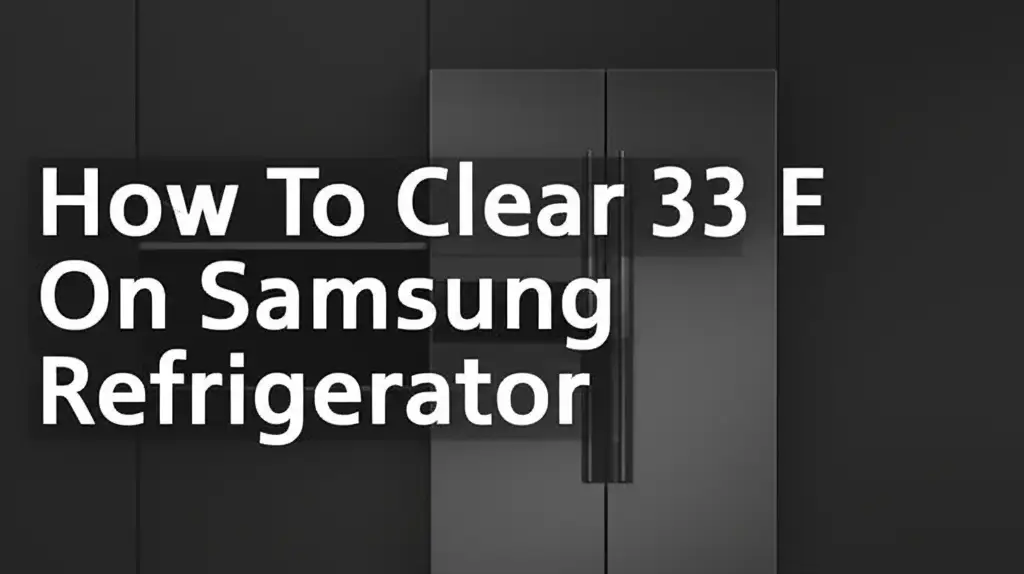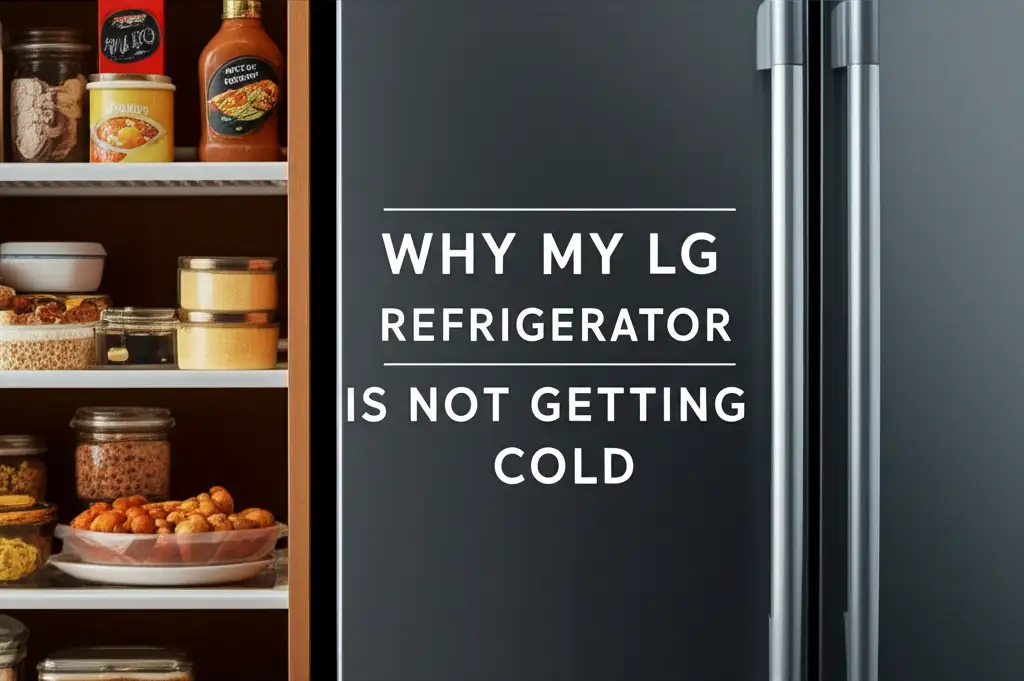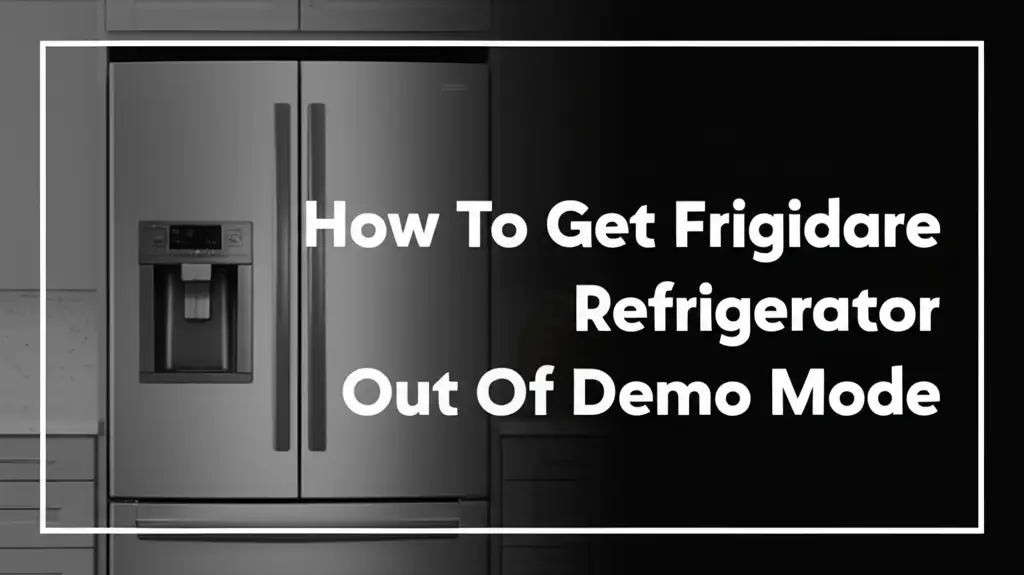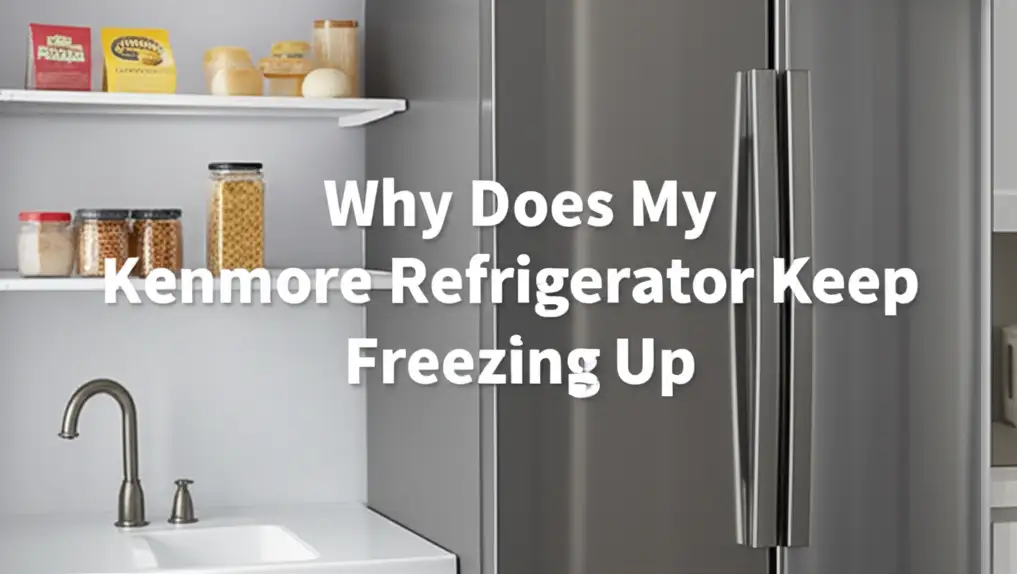· Katria Melrose · Refrigerator Troubleshooting · 18 min read
Why Is My Ge Refrigerator Not Dispensing Water After Replacing Filter
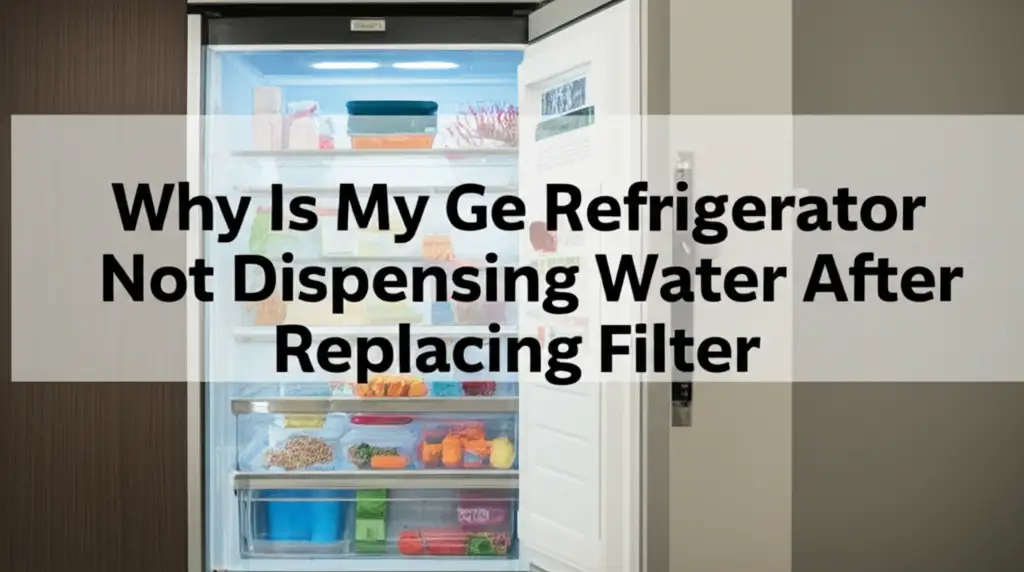
GE Refrigerator Not Dispensing Water After Filter Change? Here’s Why
I understand your frustration. You just put a new water filter in your GE refrigerator, expecting fresh, clean water. Instead, nothing comes out. It is a common problem, and many GE refrigerator owners face this after replacing the filter. You might even hear a sound but see no water flow.
This issue often makes people wonder if they installed the filter incorrectly or if a more serious problem exists. Do not worry; many reasons for a GE refrigerator not dispensing water after replacing the filter are easy to fix. I will guide you through common causes. I will also provide clear solutions to get your water flowing again. We will cover air locks, installation errors, water pressure, and other potential malfunctions.
Takeaway
- Flush the system: Always purge air from lines after filter changes.
- Check filter installation: Ensure the new filter is properly seated and the correct type.
- Verify water supply: Confirm the main water valve and fridge valve are open.
- Inspect water lines: Look for kinks or ice blockages in lines behind the fridge and in the freezer.
- Test for clogs: Clean the dispenser nozzle and check the water inlet valve.
After replacing a GE refrigerator filter, water dispenser issues often stem from trapped air, improper filter installation, low water pressure, a kinked water line, or a clogged dispenser line. Flushing the system and rechecking the filter usually resolves the problem.
Understanding Your GE Refrigerator’s Water System
Your GE refrigerator’s water system brings water from your home’s main supply to the dispenser. It first passes through a water inlet valve. This valve controls water flow into the appliance. From there, water goes to the filter housing.
The water filter cleans the water before you drink it. It removes impurities and improves taste. After the filter, the water travels through thin plastic tubing. This tubing leads to the dispenser located on the refrigerator door. Some water also diverts to the ice maker. Each component must work correctly for water to flow freely.
A key part of this system is the water pressure. The refrigerator needs enough water pressure to push water through the filter and lines. If the pressure is too low, the dispenser will not work properly. The filter also needs correct installation. An improperly seated filter can block water flow completely. If you want to know more about keeping your filters clean, you can read our guide on how to clean water filter.
Common Culprits: Why Your GE Fridge Water Stops
When your GE refrigerator stops dispensing water right after a filter change, it often points to a few specific issues. These are typically related to the filter itself or how it interacts with the water lines. Do not panic; most of these are straightforward to diagnose and fix. It is usually not a sign of a major appliance breakdown.
Understanding these common problems helps you pinpoint the exact cause. We will look at the most frequent reasons. These include air trapped in the lines and incorrect filter placement. Both can completely halt water flow. Checking these first saves you time and effort.
Air in the Water Line: The Most Common Issue
Air in the water line is the leading cause of no water after a filter change. When you remove the old filter, air enters the water lines. This air creates a blockage or an “air lock.” Water cannot flow past this air pocket.
You might hear the dispenser making a buzzing or humming sound. This sound indicates the dispenser motor is trying to pull water. However, the air prevents it from doing so. The solution is to flush the system. You need to purge the air out.
To do this, hold down the water dispenser lever for several minutes. Do this continuously, not in short bursts. You might see sputtering or air coming out at first. Keep holding it until a steady stream of water appears. It might take 2-3 gallons or about 5-7 minutes. Do this into a large container or bucket. This process clears the air and primes the system.
Incorrect Filter Installation: A Simple Oversight
Sometimes, the problem is as simple as an incorrectly installed filter. Even experienced homeowners can make this mistake. Your GE refrigerator filter needs to be seated perfectly to work. If it is not, water cannot pass through it.
First, make sure you have the correct filter type for your specific GE refrigerator model. Not all filters are universal. Second, ensure the filter is fully inserted and locked into place. Some GE models require a push and twist motion. Others might have a simple push-in mechanism. You should hear or feel a click when it is properly secured. A slight misalignment can block the water path.
It is always a good idea to remove the new filter and re-insert it carefully. Make sure the alignment tabs or arrows match up. After re-inserting, try to dispense water again. Then, flush the system as described above to remove any trapped air. This double-check often solves the issue. For general guidance on replacing filters, even on different brands, you can refer to resources like how to replace water filter in Samsung side by side refrigerator external. This helps understand the mechanics of filter replacement. Changing a filter in an LG refrigerator might have specific considerations regarding water shut-off. Learn about whether you can change an LG refrigerator water filter without turning off water for additional insights.
Water Pressure Problems and Supply Issues
Water pressure is crucial for your refrigerator’s dispenser. If the pressure is too low, water will not flow properly, if at all. This is especially true after a filter change. The new filter might add a tiny bit more resistance to the water flow. If your existing water pressure is already borderline, this resistance could push it over the edge.
It is important to check your home’s water supply. Ensure it is fully open and providing enough pressure to the refrigerator. Issues with the main supply can affect all water-using appliances. Sometimes, the problem is not with the fridge itself but with the incoming water.
Low Household Water Pressure
Household water pressure affects all your water fixtures. If your overall home water pressure is low, your GE refrigerator dispenser will struggle. This might be noticeable in other parts of your house. For example, showers might feel weak or faucets might trickle. Low pressure prevents water from pushing through the refrigerator’s internal lines and filter.
You can test your home’s water pressure using a simple gauge. These gauges attach to an outdoor spigot or laundry room faucet. A healthy pressure for refrigerators is typically between 20 and 100 psi. If your reading is consistently below 20 psi, that is likely your problem. You might need to contact a plumber to address household water pressure issues. Sometimes, local water supply issues can also cause this.
Kinked or Frozen Water Line
The water line supplying your GE refrigerator runs behind it. It then often enters the freezer compartment. This plastic tubing can easily get kinked if the refrigerator is pushed too close to the wall. A kink acts like a severe crimp, blocking water flow. Pull the refrigerator away from the wall. Inspect the water line for any bends or pinches. Straighten any kinks you find.
In colder environments, or if the freezer temperature is set too low, the water line inside the freezer can freeze. This often happens in the line leading to the ice maker or the dispenser. A frozen line will completely block water flow. If you suspect a frozen line, unplug the refrigerator. Open the freezer door. Use a hairdryer on a low setting or allow time for it to thaw naturally. Be very careful with a hairdryer to avoid melting plastic components. You can also temporarily increase your freezer temperature slightly. After thawing, plug the fridge back in and try dispensing water. You may need to flush the line again. You can also explore how to clean refrigerator ice maker water line for related troubleshooting tips.
Water Supply Valve Status
Your GE refrigerator has its own dedicated water supply valve. This valve is usually located behind the refrigerator. It might also be under the sink or in the basement. It connects the refrigerator’s water line to your home’s main water pipe. Sometimes, this valve is accidentally turned off or not fully open.
After installing a new filter, it is easy to forget to check this valve. Ensure it is turned fully clockwise. This position ensures the valve is completely open. A partially open valve will restrict water flow, causing low pressure at the dispenser. If you cannot locate it, follow the water line coming from the wall to the back of the refrigerator. This valve is your first point of check after the filter itself.
Dispenser and Valve Malfunctions
Sometimes, the issue goes beyond the filter or basic water supply. Specific components within the dispenser system itself can malfunction. These issues might not be directly caused by the filter change. However, they become more noticeable when you expect water to flow freely after a new filter is in place. These problems include clogs or failures of electrical and mechanical parts.
It is important to systematically check these elements. This helps rule out more common issues first. If air purges and filter installation are fine, then these internal components need attention. We will explore common areas like the dispenser nozzle and the water inlet valve. Understanding these helps you decide if you can fix it or need professional help.
Clogged Dispenser Nozzle
The water dispenser nozzle is where the water comes out. Over time, mineral deposits can build up in this small opening. Hard water is especially prone to causing this. This buildup can partially or completely block the water flow. If you hear the dispenser working but only get a trickle, or nothing at all, a clogged nozzle is a possibility.
You can often clean the nozzle yourself. First, unplug the refrigerator for safety. Use a small brush, like a toothbrush or a pipe cleaner. Gently scrub the opening to remove any visible mineral deposits. You can also use a mixture of vinegar and water to help dissolve stubborn buildup. Dip a cloth or paper towel in the solution. Hold it against the nozzle for a few minutes. Then, try to clean it again. This simple cleaning can restore full water flow. For more detailed instructions on cleaning, refer to resources like how to clean refrigerator water dispenser mold.
Faulty Water Inlet Valve
The water inlet valve is a crucial component at the back of your GE refrigerator. It is an electrically controlled valve that opens to allow water into the fridge. If this valve is faulty, water will not enter the system, regardless of the filter. You might hear a buzzing sound near the back of the fridge when you try to dispense water. This sound indicates the valve is receiving power but not opening.
A faulty valve can be caused by a few things. It might have low voltage, mineral deposits, or a worn-out solenoid. If you have confirmed good water pressure and a clear water line, this valve is the next suspect. Replacing a water inlet valve often requires basic tools and some DIY skills. However, it involves working with water and electricity. If you are not comfortable, it is best to call a qualified appliance technician. Testing the valve usually involves checking for voltage and continuity with a multimeter.
Damaged Dispenser Switch or Control Board
Less commonly, the problem might lie with the electrical components. The dispenser switch is what you press to get water. If this switch is faulty, it will not send the signal to the water inlet valve to open. You might not hear any buzzing sound when you press the lever. This suggests the valve is not receiving the command to activate.
The refrigerator’s main control board also plays a role. It manages all functions, including water dispensing. A problem with the control board could prevent the dispenser from working. This is usually a last resort diagnosis. It is much less likely than air in the lines or a faulty valve. Testing these components requires advanced diagnostic skills and specialized tools. If you suspect a switch or control board issue, it is highly recommended to seek professional service. These repairs can be complex and expensive.
Troubleshooting Steps and Solutions for GE Refrigerators
You have replaced your GE refrigerator filter. Now you need to troubleshoot why water is not dispensing. This section provides a systematic approach. Follow these steps one by one. This helps you identify and resolve the problem efficiently. Do not skip steps, even if they seem basic. Often, the simplest solution is the correct one.
Remember to prioritize your safety. Unplug the refrigerator before making any physical inspections or adjustments to components. This prevents electrical shock. These steps are designed for common issues. If you perform all steps and water still does not dispense, then professional help is usually needed.
Flush the Air Out:
- Action: Hold the water dispenser lever down for at least 5-7 minutes. Use a large bucket.
- Reason: This purges trapped air from the water lines and the new filter. Air locks are the most common reason for no water after a filter change.
- Expected Outcome: You might hear sputtering, see air bubbles, or get intermittent water flow at first. Continue until you get a steady stream.
Verify Filter Installation:
- Action: Remove the new water filter. Re-insert it carefully and firmly. Ensure it clicks into place. Confirm it is the correct filter type for your specific GE model.
- Reason: An improperly seated or incorrect filter will block water flow.
- Expected Outcome: The filter should sit flush and feel secure. Re-attempt flushing water.
Check Water Supply Valves:
- Action: Locate the water supply valve behind the refrigerator or under the sink. Ensure it is fully open. Also, check your home’s main water shut-off valve.
- Reason: A partially closed or off valve will prevent water from reaching the refrigerator.
- Expected Outcome: The valve handle should be turned completely counter-clockwise (for gate valves) or aligned with the pipe (for ball valves).
Inspect Water Lines:
- Action: Pull the refrigerator out from the wall. Visually inspect the water line connected to the fridge. Look for kinks, bends, or pinches. Straighten any you find. Check the water line inside the freezer compartment for ice blockages.
- Reason: Kinks restrict water flow. Ice blockages completely stop it.
- Expected Outcome: The line should be smooth and unobstructed. If ice is present, thaw it safely.
Clean Dispenser Nozzle:
- Action: With the refrigerator unplugged, use a small brush or a thin wire to clear the dispenser opening. Look for mineral buildup.
- Reason: Mineral deposits can clog the tiny opening over time.
- Expected Outcome: The nozzle should be clear of debris.
Reset the Refrigerator:
- Action: Unplug your GE refrigerator from the wall outlet for 5-10 minutes. Then plug it back in.
- Reason: This hard reset can sometimes clear minor electronic glitches affecting the dispenser.
- Expected Outcome: The refrigerator’s system reboots. Try dispensing water after the fridge has fully restarted.
Consider Water Inlet Valve:
- Action: Listen for a buzzing sound at the back of the refrigerator when you press the dispenser. If you hear buzzing but get no water, the water inlet valve might be the issue.
- Reason: A faulty valve will not open to let water in.
- Expected Outcome: If other steps fail and you hear buzzing, this component needs further inspection by a professional if you are not comfortable testing it yourself. For comparison with other brands, issues with water dispensers like those found in KitchenAid refrigerators not working after replacing filter or Maytag refrigerators not dispensing water after filter change often point to similar underlying causes such as these.
When to Call a Professional for Your GE Fridge
Sometimes, even after your best efforts, your GE refrigerator still refuses to dispense water. This can be frustrating. It is important to know when to stop troubleshooting yourself and call in an expert. Attempting complex repairs without proper knowledge or tools can cause more damage. It can also void your appliance’s warranty.
A professional appliance technician has the right diagnostic equipment. They also have the experience to quickly pinpoint the exact problem. They can safely handle electrical components and specialized parts. Knowing when to seek help saves you time, money, and potential headaches in the long run.
- No Water After All Troubleshooting Steps: If you have followed every troubleshooting step outlined above and still have no water, it is time to call a professional. This suggests an underlying component failure. Common failures include the water inlet valve, the dispenser control board, or the dispenser switch. These parts require specialized knowledge to diagnose and replace.
- Persistent Buzzing with No Water: If you consistently hear a buzzing or humming sound from the water inlet valve area but no water comes out, the valve itself is likely faulty. While some DIYers might attempt to replace this, it involves working with water lines and electrical connections. A professional ensures proper installation and prevents leaks.
- Electrical Issues Suspected: If the dispenser light does not come on, or if the entire dispenser panel is dead, it could indicate an electrical problem. This might involve wiring, the dispenser switch, or the main control board. Electrical issues can be dangerous to diagnose and repair without professional training.
- Water Leaks Occur During Troubleshooting: If you notice water leaks appearing while you are trying to fix the dispenser, stop immediately. A leak can cause significant damage to your floor and cabinets. It also indicates a problem with the water line connections or a cracked component. A technician can identify the source of the leak and repair it safely.
- Lack of Confidence or Tools: If you do not feel comfortable working with appliance parts, or if you lack the necessary tools (like a multimeter for testing voltage), it is always best to call a professional. They ensure the repair is done correctly and safely.
Remember, GE refrigerators are complex appliances. Their water dispensing system, while seemingly simple, involves several interconnected parts. Do not hesitate to contact GE customer support or a certified appliance repair service in your area. They can provide accurate diagnosis and efficient repair, getting your fresh water flowing again.
FAQ Section
Q1: How do I prime a GE refrigerator water dispenser after changing the filter?
To prime your GE refrigerator’s water dispenser, hold the dispenser lever down continuously for 5 to 7 minutes. Water may sputter or come out intermittently at first due to trapped air. Keep dispensing until a steady stream of water appears. This process purges all the air from the water lines and the new filter, ensuring proper flow.
Q2: Why is my GE refrigerator ice maker not working after replacing the water filter?
If your GE refrigerator ice maker stops working after a filter change, the cause is often similar to the water dispenser issue: trapped air or low water pressure. Flush several gallons of water through the dispenser first to clear air. Ensure the water supply valve is fully open and check for any kinks or ice blockages in the ice maker’s dedicated water line within the freezer compartment.
Q3: How often should I change my GE refrigerator water filter?
GE recommends changing your refrigerator water filter every six months. This timeframe ensures optimal water quality and consistent flow. However, if your household uses a lot of water, has very hard water, or if you notice a decrease in water flow or taste before six months, you might need to replace the filter more frequently.
Q4: Can a wrong water filter cause no water dispensing?
Yes, using the wrong water filter can definitely cause your GE refrigerator to stop dispensing water. Different GE models require specific filter types. An incorrect filter may not fit properly into the housing, preventing it from seating correctly or allowing water to pass through. Always ensure you purchase the exact replacement filter specified for your refrigerator model.
Q5: What does it mean if my GE refrigerator water dispenser makes noise but no water comes out?
If your GE refrigerator water dispenser makes a buzzing or humming noise but no water comes out, it typically means the water inlet valve is receiving power but not opening. This can be due to an air lock in the lines, a faulty water inlet valve itself (clogged or broken solenoid), or insufficient water pressure preventing the valve from pushing water through.
Q6: Do I need to turn off the water supply to change a GE refrigerator filter?
For most modern GE refrigerators, you do not need to turn off the main water supply to change the filter. GE filters often feature an internal shut-off valve that closes automatically when the filter is removed. However, if you are unsure or if your specific model is older, turning off the water supply to the refrigerator or the main household supply provides an extra layer of protection against accidental leaks.
Conclusion
It is truly frustrating when your GE refrigerator decides to stop dispensing water right after you have installed a brand-new filter. However, as we have explored, most of these issues are quite common and, thankfully, often have simple solutions. The leading culprit for your GE refrigerator not dispensing water after replacing the filter is almost always trapped air. A thorough system flush is usually the first and most effective step.
Beyond air, remember to double-check that your new filter is seated perfectly. Verify your home’s water pressure. Ensure no pesky kinks or ice blockages are in the water lines. Do not forget to confirm that all water supply valves are fully open. If you have systematically worked through these troubleshooting steps, you are well on your way to enjoying fresh, filtered water again. If, after all your efforts, the dispenser remains stubborn, that is the clear signal to reach out to
- GE refrigerator not dispensing water after replacing filter
- GE water dispenser repair
- refrigerator water problems
- fridge filter issues
- appliance troubleshooting
- GE fridge no water
- water filter replacement GE


